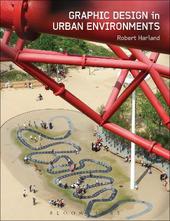
|
Graphic Design in Urban Environments
Paperback / softback
Main Details
| Title |
Graphic Design in Urban Environments
|
| Authors and Contributors |
By (author) Dr Robert Harland
|
| Physical Properties |
| Format:Paperback / softback | | Pages:152 | | Dimensions(mm): Height 244,Width 169 |
|
| Category/Genre | Graphic design
Landscape art and architecture |
|---|
| ISBN/Barcode |
9781472597748
|
| Classifications | Dewey:741.6 |
|---|
| Audience | | Professional & Vocational | |
|---|
| Illustrations |
64 colour illus and 36 bw illus
|
|
Publishing Details |
| Publisher |
Bloomsbury Publishing PLC
|
| Imprint |
Bloomsbury Academic
|
| Publication Date |
20 October 2016 |
| Publication Country |
United Kingdom
|
Description
Graphic Design in Urban Environments introduces the idea of a category of designed graphic objects that significantly contribute to the functioning of urban systems. These elements, smaller than buildings, are generally understood by urban designers to comprise such phenomena as sculpture, clock towers, banners, signs, large screens, the portrayal of images on buildings through "smart screens," and other examples of what urban designers call "urban objects."The graphic object as it is defined here also refers to a range of familiar things invariably named in the literature as maps, street numbers, route signs, bus placards, signs, architectural communication, commercial vernacular, outdoor publicity, lettering, banners, screens, traffic and direction signs and street furniture. One can also add markings of a sports pitch, lighting, bollards, even red carpets or well dressings. By looking at the environment, and design and deconstructing form and context relationships, the defining properties and configurational patterns that make up graphic objects are shown in this book to link the smallest graphic detail (e.g. the number 16) to larger symbolic statements (e.g. the Empire State Building). From a professional design practice perspective, a cross section through type, typographic, graphic and urban design will provide a framework for considering the design transition between alphabets, writing systems, images (in the broadest sense) and environments.
Author Biography
Robert Harland is a lecturer in visual communication at Loughborough University, UK. Before moving into academia, he ran his own graphic design practice, Harland Design.
ReviewsRob Harland's welcome, original and ultimately provocative book considerably widens the range of objects deemed to be urban/graphic design and provides some sophisticated analytical and critical tools with which to explain those objects. If they have any sense, it will be welcomed and used by graphic/urban designers, design theorists, urban and cultural geographers, as well as town and city planners. * Malcolm Barnard, senior lecturer in visual culture at Loughborough University, UK * Robert Harland has done nothing less than redefine graphic design as a spatial practice. He shows how an intricate text of words and images mirrors the flux of people and capital through urban space. Graphic design touches nearly every transaction in the life of a city. * Ellen Lupton, Senior Curator at the Smithsonian Design Museum and Director of the MFA Graphic Design Program at Maryland Institute College of Art, USA * Graphic Design in Urban Environments shines light into the little-explored areas between architecture, urban design and graphic design. The light reveals tantalising new ways to frame discussions of how cities function, and are designed, conceived and experienced. Its audience is as broad as the subject areas it covers - urban geography, architecture, urban design, graphic design, and it offers a critical lens for reconsidering ideas of legibility and imageability in the built environment. Most interestingly, Graphic Design in Urban Environments challenges prevailing conceptions about how we experience, understand and read cities, architecture and places. The discourse has been enlivened by this engaging book. * Neil Stacey, Senior Lecturer in Architecture at Leicester School of Architecture, UK * The main discussions proposed by Harland... are original and timely. He very convincingly explains how graphic and communication design in the urban environment have been underrepresented or even ignored in graphic design historiography and in academic and educational definitions of the field, particularly in the UK. He also effectively demonstrates the difficulties faced by urban theorists who tried to describe the presence and relevance of graphic design artefacts in the public sphere, and the gaps and shortcomings of their approach. The careful descriptions and analysis presented in the book offer a framework for thinking about urban graphic interventions in multiple scales and settings. The result is a relevant contribution to design research, and should stimulate further and welcome debates on the interface between graphic design, communication, and urban design. * The Design Journal * Graphic Design in Urban Environments should be useful to anyone interested in innovative design theory and practice. -- S. Skaggs, University of Louisville * CHOICE *
|